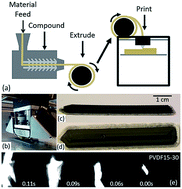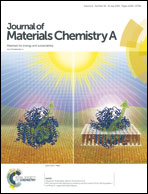3D printing multifunctional fluorinated nanocomposites: tuning electroactivity, rheology and chemical reactivity†
Abstract
Poly(methyl methacrylate) (PMMA) was added to aluminum/poly(vinylidene fluoride) (Al/PVDF) energetic blends to enhance melt flow rate and adhesion in a fused deposition modeling (FDM) manufacturing scenario. Composites were successfully printed with up to 30 wt% nano-scale Al after PMMA addition. Melt flow rate increased with increasing PMMA content. This resulted in a partially fluorinated binder that can facilitate high solids loadings and can be easily printed with a standard FDM 3D printer. PMMA addition promoted nucleation of the electroactive β-phase PVDF, which suggests the potential to print piezoelectric, energetic composites. Thermal stability was assessed using differential scanning calorimetry and thermogravimetric analysis. Results verified that composite stability decreased with increasing PMMA and Al content, however, decomposition onset temperatures for all concentrations remained well above printing temperatures. Burn rates at higher Al loadings (e.g., fuel rich) showed a decreasing trend. Analysis of post burn soot revealed α-AlF3 and amorphous carbon char as the primary reaction products. Combustion performance results indicate that although PMMA may serve as a heat sink, the reaction between Al and PVDF was not significantly affected by PMMA addition. These findings indicate that by changing PMMA concentrations, rheology, piezoelectric content, thermal properties and combustion performance can be altered to suit specific needs.



 Please wait while we load your content...
Please wait while we load your content...
